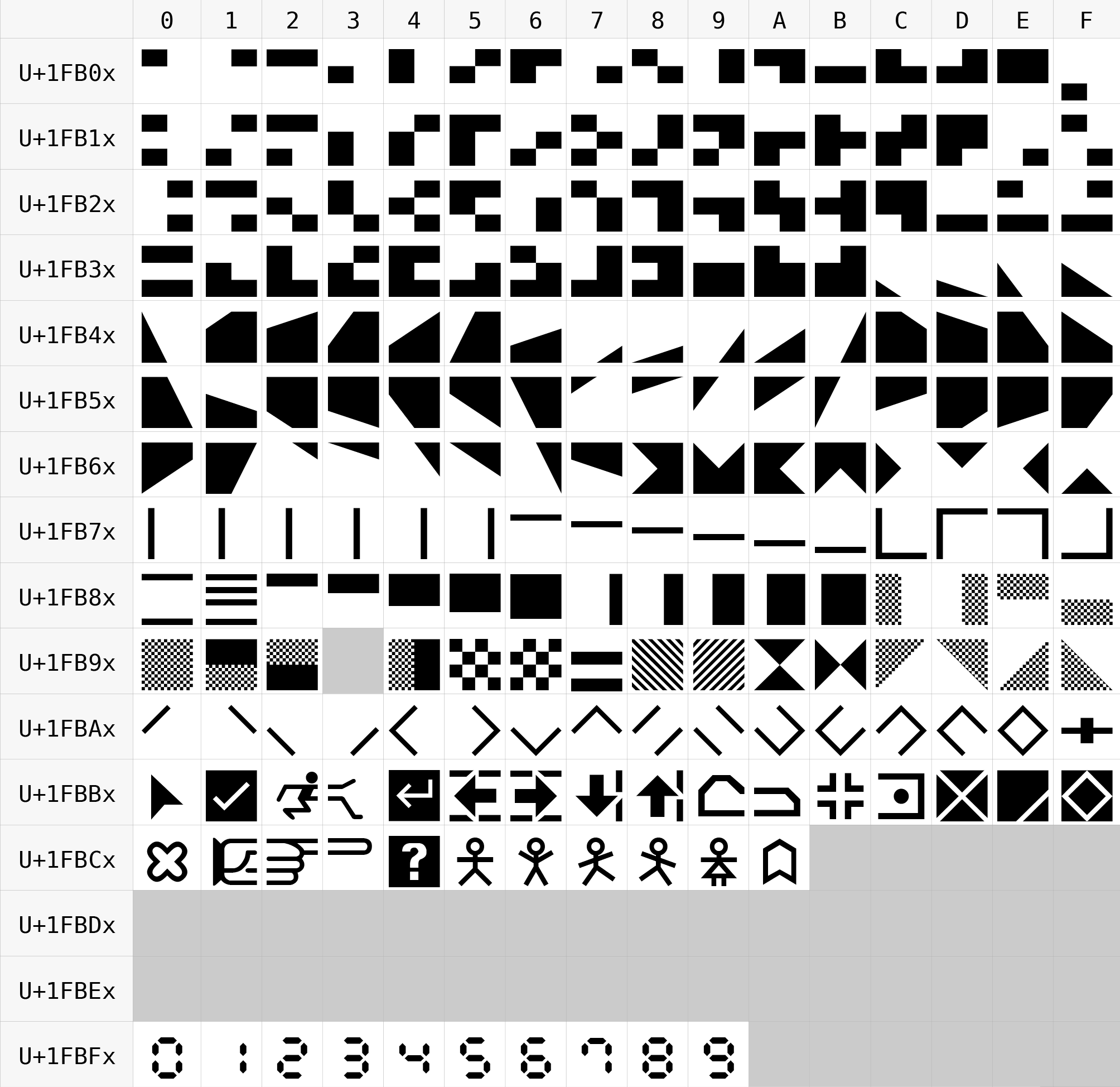🼠on:
[Wikipedia]
[Google]
[Amazon]
Symbols for Legacy Computing is a

Unicode block
A Unicode block is one of several contiguous ranges of numeric character codes ( code points) of the Unicode character set that are defined by the Unicode Consortium for administrative and documentation purposes. Typically, proposals such as the ...
containing graphic characters that were used for various home computers from the 1970s and 1980s and in Teletext
A British Ceefax football index page from October 2009, showing the three-digit page numbers for a variety of football news stories
Teletext, or broadcast teletext, is a standard for displaying text and rudimentary graphics on suitably equipp ...
broadcasting standards. It includes characters from the Amstrad CPC
The Amstrad CPC (short for ''Colour Personal Computer'') is a series of 8-bit home computers produced by Amstrad between 1984 and 1990. It was designed to compete in the mid-1980s home computer market dominated by the Commodore 64 and the Si ...
, MSX, Mattel Aquarius
Aquarius is a home computer designed by Radofin and released by Mattel Electronics in 1983. Based on the Zilog Z80 microprocessor, the system has a rubber chiclet keyboard, 4K of RAM, and a subset of Microsoft BASIC in ROM. It connects to a te ...
, RISC OS
RISC OS is a computer operating system originally designed by Acorn Computers Ltd in Cambridge, England. First released in 1987, it was designed to run on the ARM chipset, which Acorn had designed concurrently for use in its new line of Archi ...
, MouseText
MouseText is a set of 32 graphical characters designed by Bruce Tognazzini and first implemented in the Apple IIc. They were then retrofitted to the Apple IIe forming part of the Enhanced IIe upgrade. A slightly revised version was then released wi ...
, Atari ST, TRS-80 Color Computer
The RadioShack TRS-80 Color Computer, later marketed as the Tandy Color Computer and sometimes nicknamed the CoCo, is a line of home computers developed and sold by Tandy Corporation. Despite sharing a name with the earlier TRS-80, the Color Com ...
, Oric
Oric was the name used by UK-based Tangerine Computer Systems for a series of 6502-based home computers sold in the 1980s, primarily in Europe.
With the success of the ZX Spectrum from Sinclair Research, Tangerine's backers suggested a ho ...
, Texas Instruments TI-99/4A
The TI-99/4 and TI-99/4A are home computers released by Texas Instruments in 1979 and 1981, respectively. Based on the Texas Instruments TMS9900 microprocessor originally used in minicomputers, the TI-99/4 was the first 16-bit home computer. T ...
, TRS-80
The TRS-80 Micro Computer System (TRS-80, later renamed the Model I to distinguish it from successors) is a desktop microcomputer launched in 1977 and sold by Tandy Corporation through their Radio Shack stores. The name is an abbreviation of '' ...
, Minitel
The Minitel was a videotex online service accessible through telephone lines, and was the world's most successful online service prior to the World Wide Web. It was invented in Cesson-Sévigné, near Rennes in Brittany, France.
The service w ...
, Teletext
A British Ceefax football index page from October 2009, showing the three-digit page numbers for a variety of football news stories
Teletext, or broadcast teletext, is a standard for displaying text and rudimentary graphics on suitably equipp ...
, ATASCII
The ATASCII character set, from ''ATARI Standard Code for Information Interchange'', alternatively ''ATARI ASCII'', is the variation on ASCII used in the Atari 8-bit family of home computers. The first of this family are the Atari 400 and 800, ...
, PETSCII
PETSCII (''PET Standard Code of Information Interchange''), also known as CBM ASCII, is the character set used in Commodore Business Machines (CBM)'s 8-bit home computers, starting with the PET from 1977 and including the C16, C64, C116, C1 ...
, ZX80
The Sinclair ZX80 is a home computer launched on 29 January 1980 by Science of Cambridge Ltd. (later to be better known as Sinclair Research). It is notable for being one of the first computers available in the United Kingdom for less than a ...
, and ZX81
The ZX81 is a home computer that was produced by Sinclair Research and manufactured in Dundee, Scotland, by Timex Corporation. It was launched in the United Kingdom in March 1981 as the successor to Sinclair's ZX80 and designed to be a low-cos ...
character sets, as well as semigraphics
Text-based semigraphics or pseudographics is a primitive method used in early text mode video hardware to emulate raster graphics without having to implement the logic for such a display mode.
There are two different ways to accomplish the emu ...
characters.
Block
The image below is provided as quick reference for these symbols on systems that are unable to display them directly: :
History
The following Unicode-related documents record the purpose and process of defining specific characters in the Symbols for Legacy Computing block:See also
*Supplemental Arrows-C
Supplemental Arrows-C is a Unicode block
A Unicode block is one of several contiguous ranges of numeric character codes ( code points) of the Unicode character set that are defined by the Unicode Consortium for administrative and documentation ...
Unicode block characters and
* Block Elements
Block Elements is a Unicode block containing square block symbols of various fill and shading. Used along with block elements are box-drawing characters, shade characters, and terminal graphic characters. These can be used for filling regions of th ...
References
{{reflist Unicode blocks